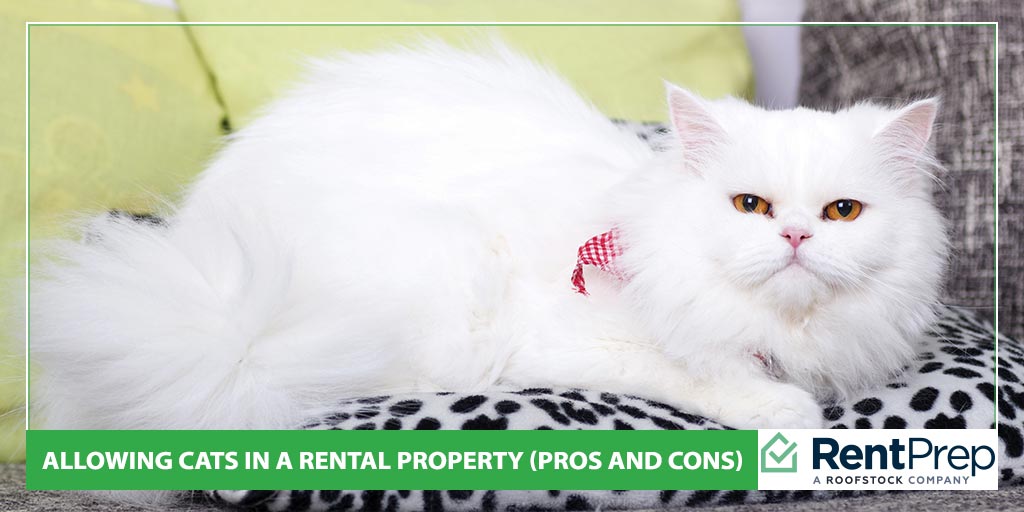
The dilemma of whether or not to allow pets in a rental property has landlords weighing in on both sides of the issue. While a lot has been said about dogs—from breeds and sizes to barking issues—the conversation isn’t as robust when it comes to cats. At first glance, it seems like cats would be ideal pets for a rental property. Landlords should take a look at whether or not their policies for or against cats are sound or whether they should take another look.
Cats and Rentals
There are plenty of exceptional tenants who want to live with their cats in a rental property. Statistics show that there are 36 million households with cats, and approximately 30% of all the households in the US own cats.
Because so many landlords ban all pets outright, there is a big demand for rental properties that allow them.
Many landlords simply don’t want the hassle and mess that go along with tenant pets, including cats. While some pet owners are great, many are not, and landlords often don’t want to spend time dealing with pet problems. It’s often easier simply to ban all pets rather than get into arguments with tenants. Of course, it’s important to note here that cats that are designated as service animals and companion animals are not subject to the same restrictions as those that are pets. For more information on service or assistance animals, click here.
Cats can be considered a fine alternative to dogs as pets for many reasons. Animal noise is rarely an issue, and cats don’t need the exercise that dogs of all sizes do. There’s virtually no risk of bite dangers like with dogs, and indoor cats are rarely even seen, unlike dogs who are often out on the property. Dog droppings are annoying to other tenants, while felines generally choose hidden areas outdoors or eliminate in their litter boxes. All in all, it may seem like an easy thing to allow cats in a rental property, especially when compared to dogs.

However, with pet cats, there are some associated negative behaviors that landlords may not want to invite into their rental property. Such behaviors include bringing in fleas and mites, scratching walls and door frames, climbing blinds, urinating on the carpet, litter box odors, spraying, triggering neighboring tenant allergies, and more. Cat urine in particular is notable for its distinct, lingering odor that is fairly difficult to remove.
Like any pet, the impact of the cat on the property depends primarily on the pet owner. Tenants who take great care of their pets and keep things clean can make it seem like a feline hardly lives there. However, tenants who are less than conscientious can open the door to everything from allergies and odors to severe carpet and pad damage.
Allowing Cats In A Rental Property
Pet-owning tenants may be worth courting by allowing cats in the rental property, because they have limited options, usually stay put longer, and are more likely to pay a higher deposit or separate pet deposit in order to keep their cat. Landlords may be able to take advantage of the scarcity of pet-friendly rentals and have their pick of top-notch tenants.
Other landlords may feel like tenants are very likely to sneak a cat or two or more into the rental property regardless of the rules, and they would rather get ahead of any problems and collect a pet deposit. Landlords who discover a cat has been living in a recently vacated apartment without their permission may not want to make the same mistake again.
Landlords who decide that it is to their advantage to allow cats in their rental properties would be wise to approach things in the right way, and it all starts with the lease agreement. A pet agreement is a mandatory part of the lease to outline the rules and regulations regarding felines.
Here are several things that the pet agreement should include, specifically in regards to cats:
- Specify what kinds of cats are allowed and how many.
- Request copies of any vaccinations and vet records.
- Ask for copies of licenses as outlined by the city or municipality.
- Require tenants to be responsible for their cat at all times.
- Remind tenants that cats should not be left along for long periods of time.
- Include the steps of what will happen if the tenant violates any of the pet policies.
- Clarify that tenants are responsible for any damage that the feline does to the rental.
- State the amount of the pet fee (after checking the state laws on amounts).
By documenting the rules, and implementing smart cat ownership policies, tenants know what needs to be done in order to have the privilege of bringing a cat into the rental.
Interviewing An Applicant And Their Pet

Most landlords understand that the problem with cats isn’t usually the animals, but their owners. When cats spray, scratch, urinate outside the litter box, and otherwise behave badly, it’s because the owners haven’t taken proper steps to train their cat. Landlords should take the time to check out the animal as well as the owners before approving them as tenants.
Here are five questions that landlords should ask about the applicant’s cats:
- How old is the animal and how long have the applicants owned it?
- Is the animal spayed or neutered?
- Is the animal exclusively kept indoors, or is it an indoor/outdoor pet?
- How do the owners plan to keep fleas under control?
- How do the owners plant to keep scratching under control?
Landlords should also feel free to contact the applicant’s previous landlords to ask about the feline’s behavior and how well the tenants cared for it. There could even be questions as to the amount of damage, if any, that was done to the previous rental.
If landlords determine to the best of their ability that the applicants have a spayed or neutered cat that is primarily kept indoors and has adequate scratching surfaces, the risk of property damage is fairly low. Keeping the litter boxes clean and being vigilant on pet hygiene is up to the tenants, and landlords will have to go with their instincts and the previous landlord’s assessment before making a final decision.
Welcoming Cats To The Rental Property
Landlords who make the decision to allow cats in the rental property can protect themselves and their real estate investment by carefully outlining the rules and regulations for occupancy, just as they would tackle any other tenant issue. By having a pet agreement signed by both parties, there won’t be any surprises, and getting as much as possible in the form of pet deposits or fees can help offset any issues that the cats might cause. In the long run, many landlords find it worthwhile to welcome cats because it also could mean welcoming some of the best and most conscientious tenants out there.
How to convince a landlord to allow a cat
If your landlord has a no pet policy it will be difficult to convince them to allow your cat on the property. There are a few things you can do in order to make a favorable impression. Show the landlord documentation of shots and veterinarian visits. Offer a pet deposit for any damages and provide any references from former landlords (if favorable). A cat groomer tool can be helpful for minimizing loose hair as well.

